I am a big racing fan, but I never thought I could combine it with my passion for board gaming. I mean, how are you going to adopt such a dynamic sport to a static board? So, I went to research, and to my surprise, there are several games out there that do just that. I made a compilation of the Best Auto Racing Board Games in 2023 for You.
Introduction to Best Auto Racing Board Games for 2023
If we divide the games by how they move cars on the racetrack, we have two major groups:
- Games that use several dice, combined with gear changing and other restrictions, like the maximum gear you can take a corner in.
- Games that use cards for movement and/or events. There are multiple ways of doing that; drawing pre-game, pre-turn, managing your hand, drawing events and special cards, and similar.
There is no ultimate system, with both groups relying on luck at some point. So don’t treat these games like the ultimate test of your strategical wits (although they offer a decent amount of that), but rather like good old-fashioned fun.
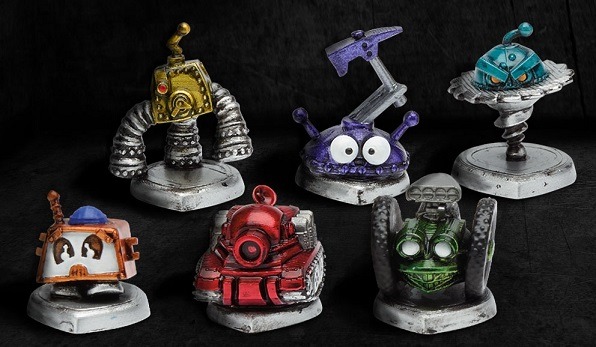
When it comes to complexity, these games are mostly pick-up-and-play. They are simple to learn and teach; you can play them minutes after setting up, even if you are new. Game duration is around 1-1.5 hours, often shorter and they work best with medium to large groups (4+ players). Grand Prix even allows up to 11 players.
All that combined, auto racing board games make for great party or family evening games, especially if there are racing fans included.
Table of Contents for Best Auto Racing Board Games
To quickly navigate through the article, click on a title below.
| Image | Title (click to quickly navigate through the article) | Tags | Price |
|---|---|---|---|
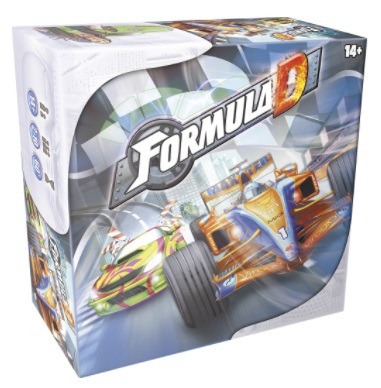 | Formula D | formula, dice | $$$ |
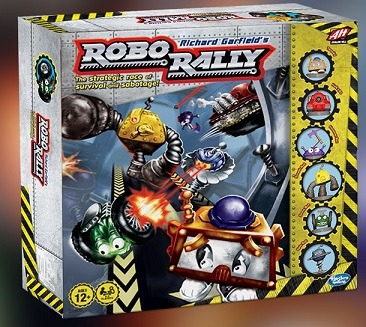 | Robo Rally | robots, programming | $$$ |
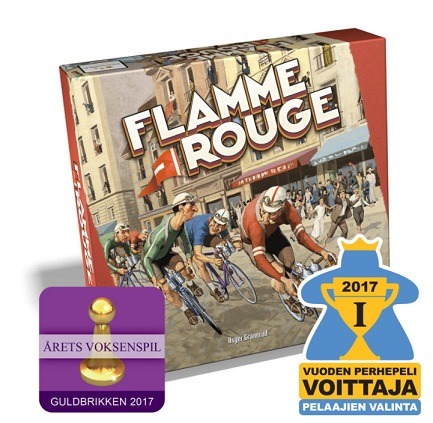 | Flamme Rouge | cycling, cards | $$$ |
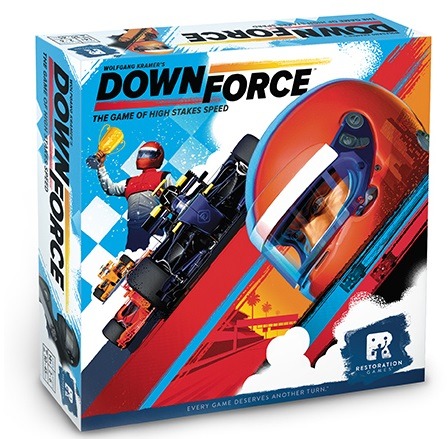 | Downforce | formula, betting | $$$ |
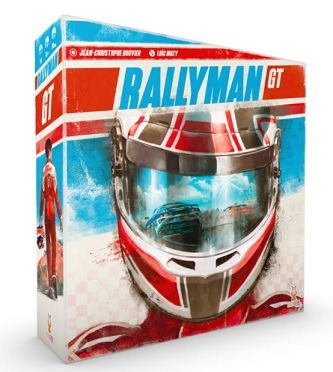 | Rallyman: GT | modular, push-your-luck | $$$ |
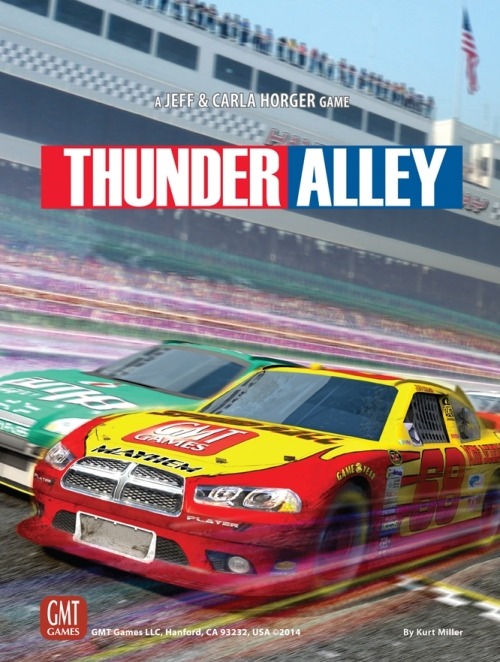 | Thunder Alley | oval racing, cards | $$$ |
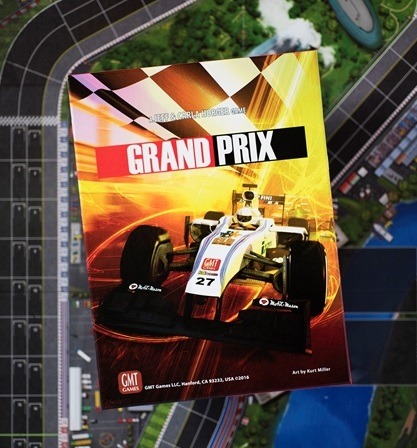 | Grand Prix | grand prix racing, cards | $$$ |
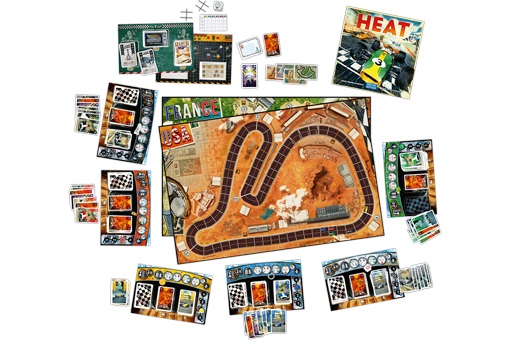 | Heat: Pedal to the Metal | vintage F1, hand-management | $$$ |
| Conclusion | with personal recommendations |
Formula D
Designers: Laurent Lavaur, Eric Randall
Published in 2008
Players: 3-10, best with 5-8
Playing time: 60 minutes
Complexity: light

It’s F1 …
Formula D is heavily inspired by Formula One. In the base game, you get two tracks. One is a fictional road course, while the other is the Monaco F1 circuit in all its glory. 20 cars are included, from open-wheelers to road cars. With expansions, even more real (F1 and non-F1) tracks are available to race on.
… with dice
Mechanics are simple and original at once. Movement around the track is done by rolling different dice – one for each gear. Higher gears take you further, but the twist is that you have to slow down for corners (you need to end your turn in the colored area of the corner), meaning you have to take them in lower gears. Otherwise, you risk taking damage to your tires, and other components or even spinning out and retiring.
Changing gears one up/down is free while changing more gears comes with a penalty to your gearbox. If your components are too damaged, you are out of the race. The race lasts for one or more laps.
The trick is to carefully select your gears and make changes at the right time, to ensure that your turns end in the required area. Too high gear and you may miss the corner, too low and you will be too slow. You can even take some calculated risks to tires to outpace rivals.
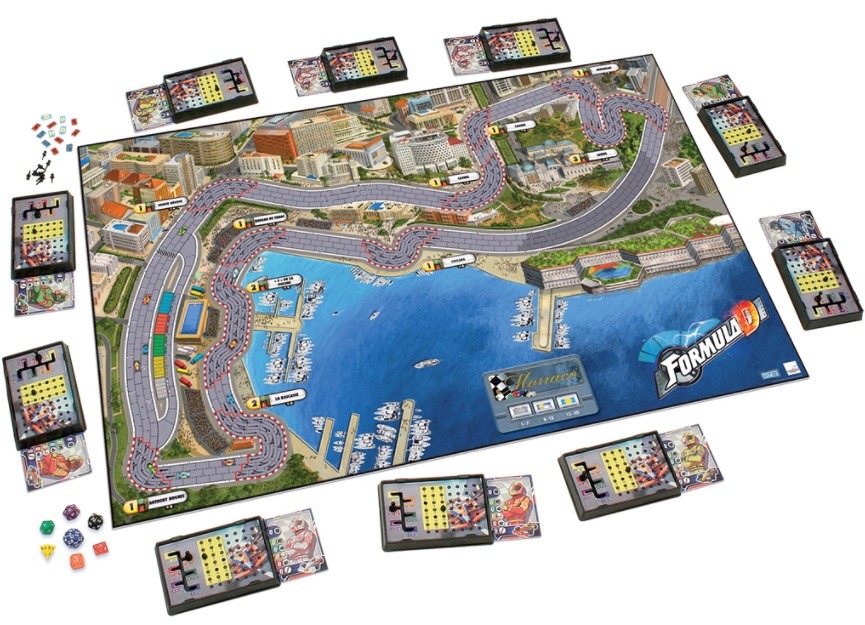
Expansions
The game has changed hands from publisher to publisher several times (formerly known as Formula Dé), but all the expansions work with any base game. And there are a lot of expansions – by expansions I mean additional tracks.
If you’re a racing fan, you’ll probably get excited by the following names: Monza, Hockenheim, Silverstone, Suzuka, Interlagos, Imola, Spa, Long Beach, Zeltweg, Melbourne, Nurburgring, Indianapolis, Sebring, and Austin, to name a few. Racing heaven.
Formula D Standout Features
- A deep dice-rolling mechanism, simulating gear changes, and component wear.
- A lot of additional content (real tracks) is available.
- More players the merrier.
Robo Rally
Designer: Richard Garfield
Published in 2016
Players: 2-6, best with 4
Playing time: 20-120 minutes
Complexity: light/medium

Theme
Monday to Friday, robots work their butts off at the local automobile factory. They help build supercars, but can only dream to see them in action. So, what do our robots do on the weekends? That’s right, they race around the abandoned factory!
Programming your robot
Each player controls his robot as they race them on the map of the factory. Six double-sided maps are available with the base game.
The factory is full of lasers, holes, conveyor belts, and other industrial machinery you must avoid – or use to your advantage! The first player to reach all the checkpoints is the winner.
You control your robot with a deck of twenty cards, containing orders like Move, Move 2, Back, Turn Left or Right, Again, Energy, and similar. Each turn you draw nine cards and then select five to be played out in order – you program your robot.
There are perils that make your job harder: robots can receive damage cards into their decks. Those are basically empty cards – you can remove them from play if you select them for play.
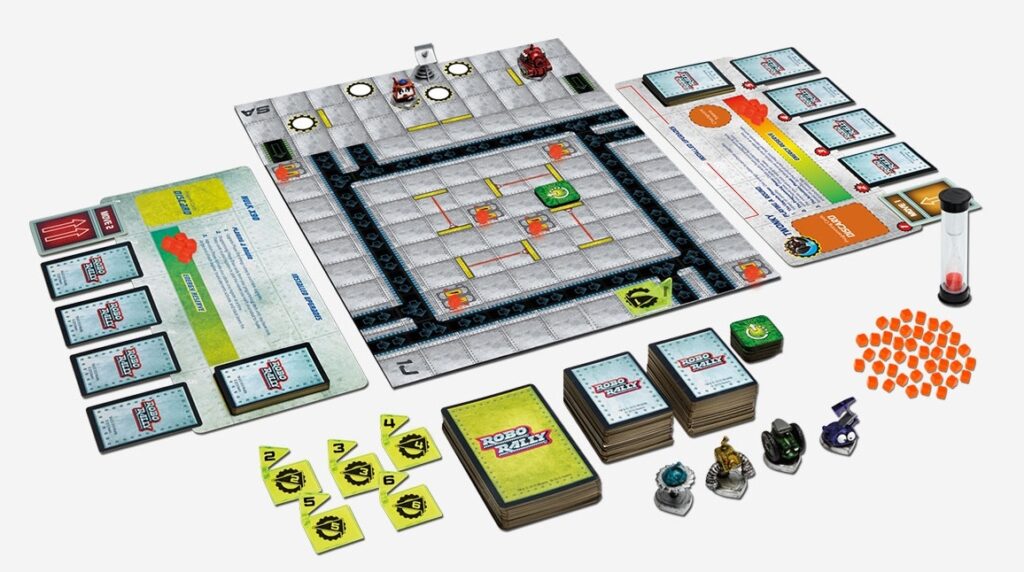
Robo Rally Standout Features
- Fun theme, the game does not take itself too seriously.
- Programming robots offers a lot of tactical options.
- No expansions are available for the 2016 edition (there are five for the 1994 edition).
Flamme Rouge
Designer: Asger Harding Granerud
Published in 2016
Players: 2-4, best with 4
Playing time: 30-45 minutes
Complexity: light

Cycling
Pushing your foot to the floor to control a couple of horses under the hood is one thing, but doing the racing with your own two legs is another! Enter Flamme Rouge, a cycling simulator.
Since the stages in a cycling race can be hours long, Flamme Rouge does not bother with that. Instead, it is focused on the end-stage sprint. Getting to the finish line first and taking all the glory is what matters after all.
Cycling is a team sport. Therefore, every player controls a team of two: a Rouleur and a Sprinteur. They are about to enter the last kilometer (the Flamme Rouge point) of the stage, together with up to three other teams. Any of them can be the first across the finish line.
Slipstreaming and Exhaustion
Moving is done with the help of card decks, where every rider has an identical deck to start with. Every round, players draw four cards per deck and play out one. Cards are executed after players simultaneously flip them face-up.
After the cyclists are moved, played cards are removed from the game. Slipstreaming (if there is 1 space between packs, the rear pack is moved forward) and exhaustion (the cyclist in the front takes the exhaustion card) take place.
Slipstreaming is crucial for a good result. With clever play, you can gain several spaces per round and with finite decks, every space counts at the end. Exhaustion cards have a movement value of two and can be very precious when catching to get a slipstream or at the finish, where the one furthest across wins (because usually, several riders will finish on the same round).
Positioning, teamwork, looking for opportunities, and blocking opponents are skills needed for victory.
The track is modular, meaning several layouts can be built with the base game. There are even mountains with capped movement cards and no slipstream and narrow one-wide sections that don’t allow overtaking.
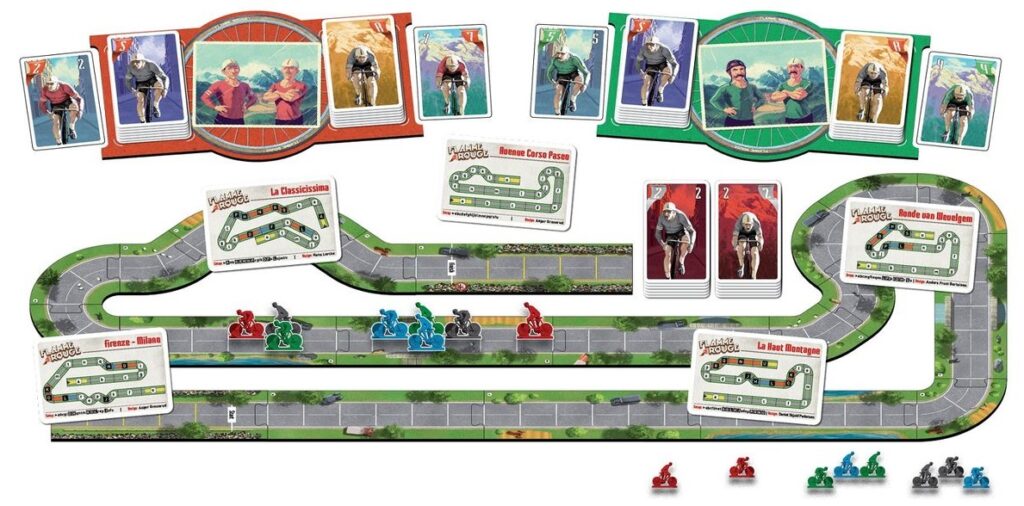
Major Expansions
- Peloton, the first expansion adds several features. There are single-lane cobblestone sections and wider three-lane sections. New riders allow up to six players. If you don’t have that many players, rules for the AI riders are included. AI riders add a bit of unpredictability and are a good addition to increasing variety.
- Meteo is a smaller expansion that adds weather: storms, head, and side winds. These affect your riders and must be taken into account.
Flamme Rouge Standout Features
- Simple, yet somewhat realistic depiction of cycling.
- Depleting decks build up tension
- A good mixture of luck and strategy.
Downforce
Designer: Wolfgang Kramer
Published in 2017
Players: 2-6, best with 3 or 6
Playing time: 20-40 minutes
Complexity: light

Team owner
While racing is exciting, it’s only a part of the circus. Managing a team takes a different set of skills. Take a step back, look at the bigger picture, and profit not only from your cars but also from wisely betting on the outcome of the race.
The object of the game is not to win the race (but it can sure help), but to make the most money. Either by racing or by bidding on the right cars.
Bet and race!
Movement is directed by a deck of cards. When the deck is evenly dealt out (more players, fewer cards you get), players first bid on the cars. You want cars that your deck favors, to have the maximum chance of winning.
You are staking your future winnings here, so be careful how high you go. In the worst-case scenario, you can dig yourself a hole too deep to climb out, even if you afterward manage to win the race.
In turn, every player plays one card. This card moves all the cars, but at different speeds (different number of spaces). If the car can’t move forward (blocked by another car), its move points are lost.
It comes down to playing the right card at the right time. Make sure you’re the one benefiting from it the most, while also trying to immobilize others in the traffic or at a choke point. Each player has one special power card, which can mitigate some obstacles or amplify movement.
But even if you don’t do all that well on track, all is not lost. During a race, there are several betting rounds where players can bet on the cars they think will finish at the top. After the finish, the prizes are given out, your initial car bids are deducted and the winner is calculated.
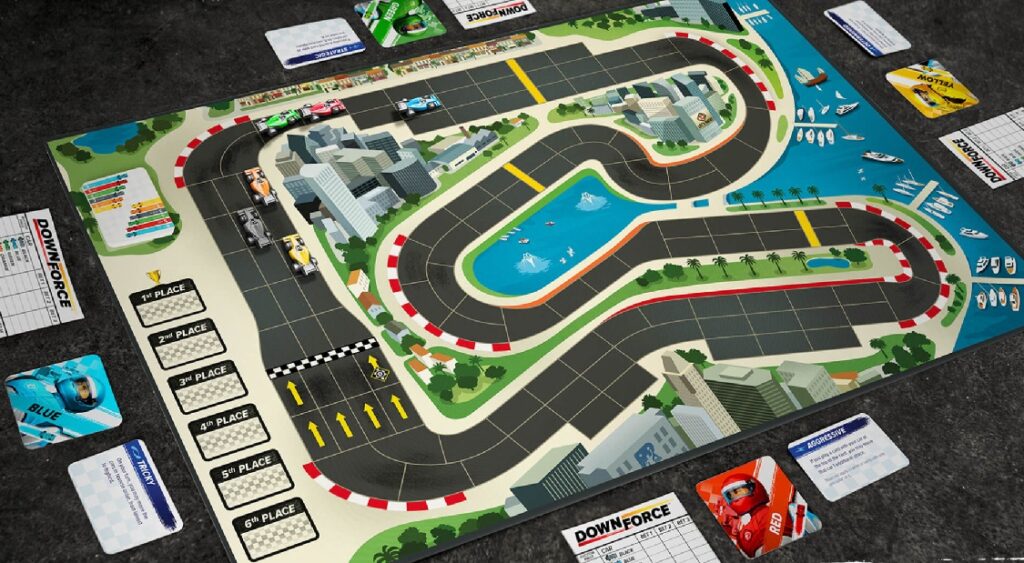
Expansions
- Danger Circuit adds two new tracks on a double-sided board and six new special powers cards.
- Wild Ride comes with two more tracks (again on a double-sided board). They feature jump ramps and wild animals crossing, adding more variety.
If you’re into betting and racing, check out Camel Up Review
Downforce Standout Features
- With betting, there’s more to think about than just racing.
- A lot of player-vs-player interaction.
- Nice components.
Rallyman: GT
Designer: Jean-Cristophe Bouvier
Published in 2020
Players: 1-6, best with 4
Playing time: 45-60 minutes
Complexity: light/medium

Sim-board-racing
We’re back to pure racing and Rallyman GT is a simulation if there can ever be one as a board game. The goal, of course, is to finish first and the base game comes with hexagon tiles which are used to build tracks. Only your imagination is the limit to how many you can build.
Gear dice, cruising, and braking
Cars in Rallyman GT come with six gears and there is a die for every gear. There are also two cruise dice (for when you don’t change gears) and a brake die, that allows you to skip a gear when braking. You can use any number of dice per turn, but not more than once.
The trick is in the sequence. For every successful die, you advance a square. Dice must be played out in order of gears – you either go up or down the gears, with cruises and braking in there. But every die comes with a Hazard symbol. Roll enough Hazards and you will spin out, making you lose a lot of time.
First, you plan out a dice sequence you intend to go through in the next section of the track. What gear you’re currently in, are there any gear requirements for the corners up ahead, are opponents blocking my way, what gear are they in? You can only pass them if you’re in a lower gear than them.
Push it to the limit
Then it’s time to start pushing your luck. You roll the dice one by one, deciding on the number of rolled hazards, and how far you want to push. Or, if you’re feeling lucky, you can roll all the desired dice at once and get a focus token as a reward (it can be used to skip the dice later on). But you can’t control the hazards this way, so you likely won’t roll as many dice – or you will spin more likely.
It’s a great system of risk and reward. Gear changes simulate reality and you feel just like racing for real. You will accelerate, cruise, then brake hard for the hairpin, just like Lewis Hamilton.
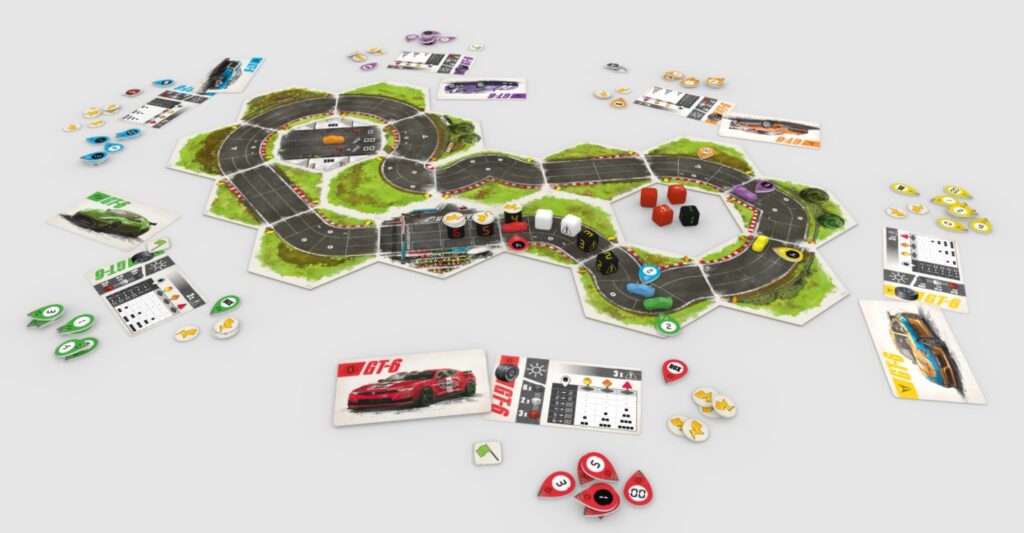
Expansions
A few smaller expansions have been released. They introduce new track tiles and cars that only have 4 or 5 gears (but more coast dice).
For 2023, Rallyman DIRT, an off-road edition has been announced. It’s said you’ll be able to combine both games into one.
Rallyman: GT Standout Features
- Modular race track.
- Innovative push-your-luck movement system.
- Includes solo “time trial” mode.
Thunder Alley
Designers: Jeff and Carla Horger
Published in 2014
Players: 2-7, best with 4-5
Playing time: 90 minutes
Complexity: light/medium

Oval Racing
If you’re a NASCAR fan, Thunder Alley is your best chance of re-living it in a board game. Drafting, teamwork, accidents, yellow flags, pit strategy, working to lead laps, and sprints to the finish are all included in the package.
The game is not just about finishing first, but also about teamwork. Results from all your cars count. Depending on the player count, one can control 3-6 cars. Four included tracks are inspired by real-life venues, but unfortunately don’t have real names.
Game Mechanics
The movement of the cars is determined by the cards in your hand. You activate one vehicle per turn by playing a card, but that vehicle is not necessarily the only one that moves. There are four types of cards:
- Solo only moves the car activated.
- Pursuit also moves cars in front.
- Leader also moves cars behind
- Draft also moves cars in front and behind.
This means the trick is to use the synergy of different cards together with the position on the track to be fast. You need a lot of cooperation inside the teams, as well as between different teams. There is a lot of room for planning and tactical maneuvers, but luck also plays a role.
To spice things up, there are further game mechanics, such as switching lanes and events like damage and pit stops.
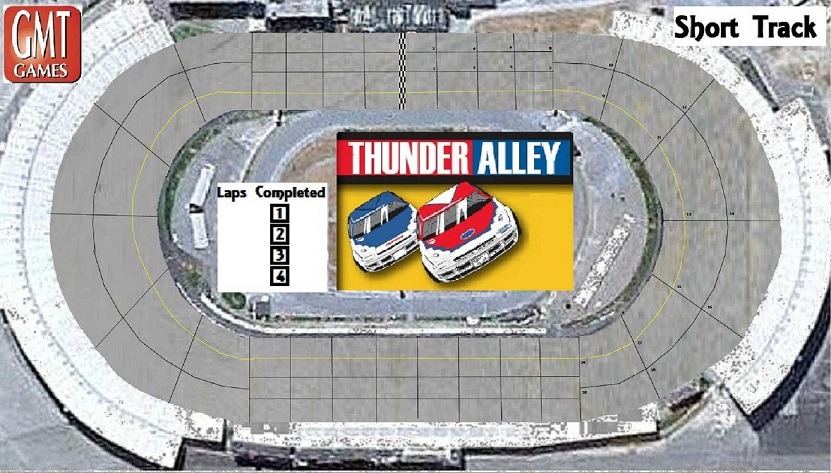
Major Expansions
- Expansion Tracks don’t need much description. Four new tracks, like Sonoma and Daytona, are included, albeit with different names. This pack also works with Grand Prix (look below).
- Crew Chief Expansion adds a new deck of cards for each player, introducing the crew chief. It allows for more race strategies and control over a race.
Thunder Alley Standout Features
- Stock car racing feel with all the rules and features.
- Players are forced to work together, just like on the real oval.
- Real tracks are available, although with fake names.
Grand Prix
Designers: Jeff and Carla Horger
Published in 2016
Players: 3-11, best with 6
Playing time: 90 minutes
Complexity: light/medium

Grand Prix Racing
This is Thunder Alley, adapted for Grand Prix racing. The rules are similar, but there are some changes.
Teams are now made of only 2 cars (just like real F1) and players can control one team, multiple teams, or a team plus non-scoring cars. Grid is always full, to ensure that real Grand Prix feel. Four tracks are included in the base game, unfortunately fictional.
Game Mechanics
Scoring is another aspect that is changed – you can now also play for individual results with the usual team scoring also present. Movement is similar to Thunder Alley, with four movement cards: Line, Pursuit, Lead, and Solo.
The main difference is the tracks. Forget open ovals, tight tracks with limited passing opportunities require finesse and skill to make it to the front. While the types of cards are similar, events and abilities are altered to give you more of a Formula One feel: fewer yellow flags and frequent pitting with three different tire compounds require a more “European” approach to racing, just like the real series.
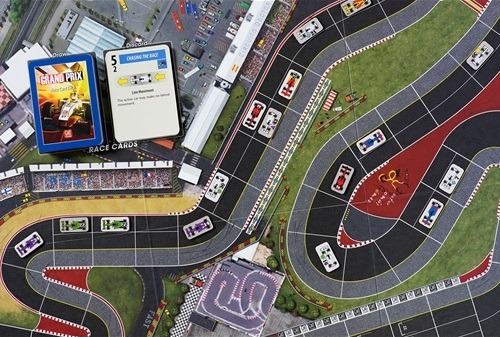
Expansions
- New Track Pack adds four new racetracks, based on the famous Silverstone, Monza, Monaco, and Spa. Tracks can also be used with Thunder Alley.
Grand Prix Standout Features
- Very accurate Formula One rules
- Twistier tracks allow for much more interaction.
- Can be combined with tracks from Thunder Alley (and vice-versa).
Heat: Pedal to the Metal
Designers: Asger Harding Granerud, Daniel Skjold Pedersen
Published in 2012
Players: 1-6, best with 5-6
Playing time: 30-60 minutes
Complexity: light/medium

Grand Prix Legends
Our final entry is thematically heavily inspired by the 60’s F1 racing. The times when a racecar was not far from a coffin on wheels and when men opted not to wear seatbelts because they preferred to be thrown out than to stay in a burning wreck.
Game Mechanics
Mechanically, Heat is based upon Flamme Rouge, but it’s much improved. Hand management is the name of the game, more specifically managing your gears and heat cards. For example, you now have corners whose recommended speed you don’t want to exceed (or you get heat cards), the gear you’re in translates into how many speed cards you can play, there’s slipstreaming, cooling, boosting, and so on.
This translates into very exciting gameplay, where you must carefully plan the speeds and gears, when to take heat, and when to cool heat. Surprisingly, this somewhat realistically simulates grand prix racing, but moreover, it creates an interesting race on your table.
Several tracks are available, as well as numerous customization options, AI cars, and even a championship mode.
Heat: Pedal to the Metal Standout Features
- Superb hand management gameplay.
- Fantastic looks.
- A lot of content in the box.
Conclusion
Every game brings something different to the table. For F1 fans there’s Formula D with its dice and gear movement; or if you prefer card-based movement, you’ve got Grand Prix (or Thunder Alley, if stock car racing is your thing). Add some speculation and Betting and you get Downforce.
If you stay with dice, you can’t miss with Rallyman: GT. Its push-your-luck mechanics are top-notch and the modular game board adds longevity.
For mindless fun, Robo Rally delivers a ton of it. And for something eco-friendly, you can go cycling in Flamme Rouge.
Oh, and don’t forget Thunder Alley and Grand Prix can interchange tracks between them!
There’s something for everyone, but my personal favorite is Heat.
Further Reading
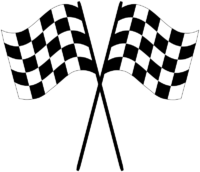
I love all kinds of table-top gaming, while I am not a huge racing fan in general, a lot of these games look like a blast to play. I definitely want to check out Robo Rally. Before reading this article, the only racing game I was aware of was Mille Bornes.
Rallyman: GT also sounds interesting, I love push your luck mechanics.
A lot of modern racing board games have their roots in Mille Bornes.
Hey nice article you have there. My experience with Robo Rally had been awesome. The Obstacles in Robo Rally include conveyor belts, pits, lasers, weapons fired by other robots, your own inability to remember left from right under pressure and the fact you can be shoved entirely off course by one of the other bumbling bots.
I’m glad you love it. 🙂